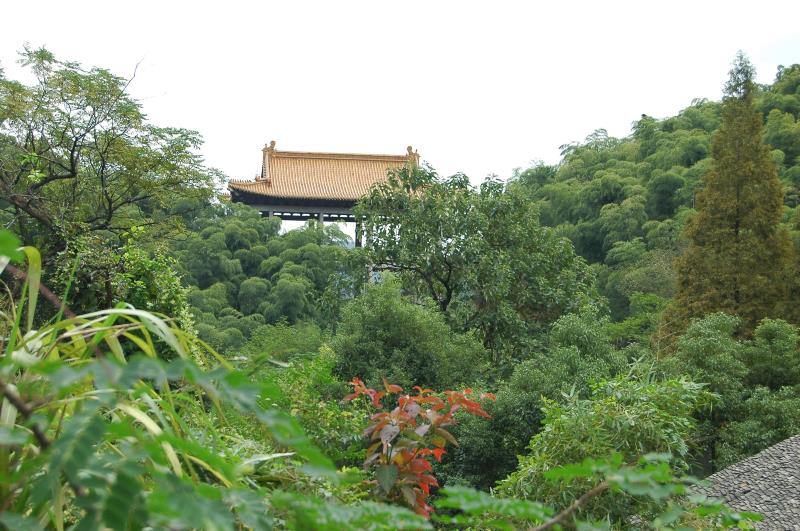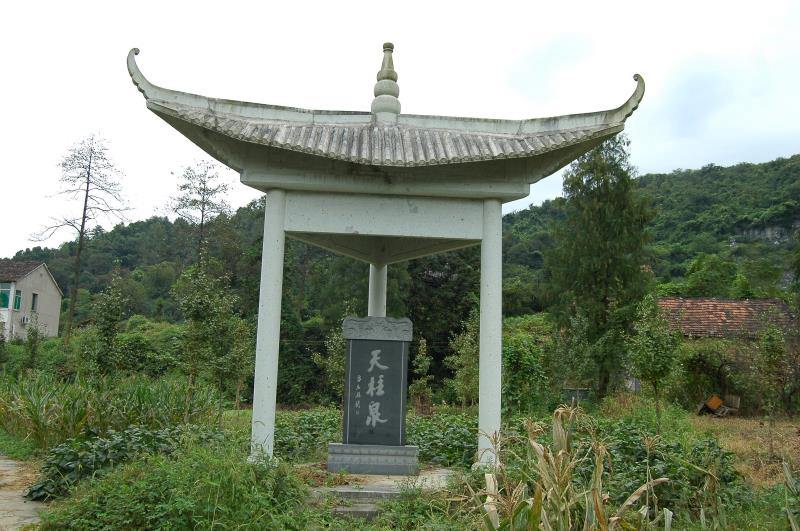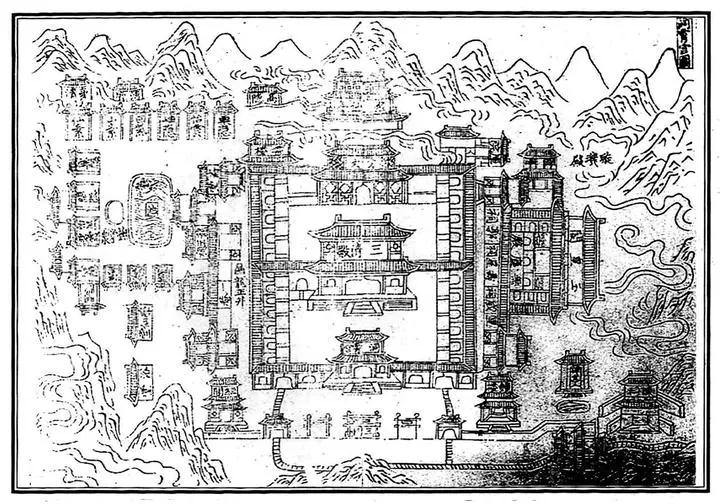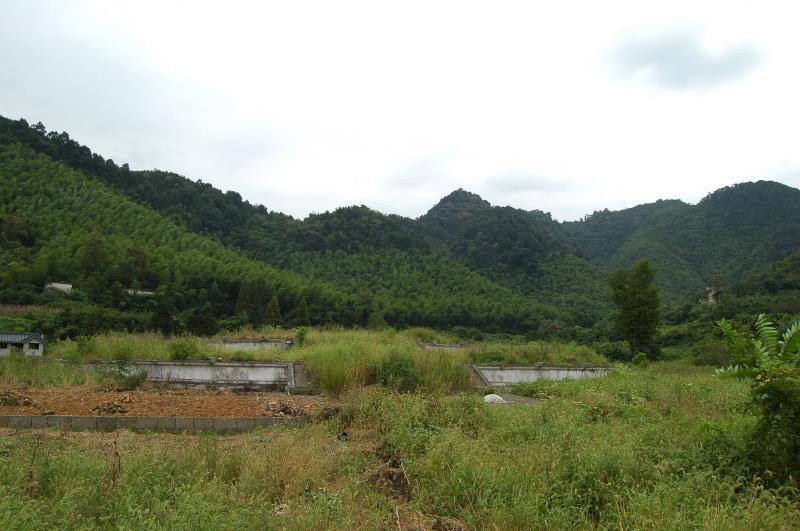浙大教授提议,重建有1800多年历史的洞霄宫,让洞霄宫这个陌生又响亮的名字引起了社会的关注。
“此夜芭蕉雨,何人枕上闻”。一生隐居西湖孤山的林逋曾在《宿洞霄宫》中写下这样的动人诗句。近日,浙江大学旅游与休闲研究院庞学铨教授提议重建有1800多年历史的洞霄宫。
洞霄宫,这个陌生又响亮的名字引起了社会的关注。
说它陌生,是因为普通百姓了解得并不多。洞霄宫主体建筑已经损毁,道观风貌湮没在岁月流逝中。
说它响亮,是因为在历史上,洞霄宫声名赫赫,历代文人骚客包括林逋、苏东坡、陆游等都留下大量诗词。
一
出杭州城往西,沿杭昱线途经古镇老余杭继续前行约10公里,就到了杭州市余杭区与临安区交界处的汪家埠。再向左行两公里许,就可抵达曾经的南宋行宫——位于大涤山中峰大涤洞旁的洞宵宫遗址。

展现在人们视野里的标志性建筑是一座石碑坊,石碑正上方的“九峰拱秀” 四个隶体字,刚劲有力,两旁还有“文官下轿,武将下马”的字样。毗邻的淙淙溪流沿公路蜿蜒而上。
同行的朋友告诉我,洞霄宫遗址在现余杭区中泰街道九峰村与临安区青山湖街道宫里村之间,两村以一溪为界,历来是共饮一涧水,同行一条道。

再往前走,迎面而来的是人称九锁山的九重青山。途中有小桥,小桥边上有一个洞,传说是钱镠来洞霄宫时,有凤凰从洞中飞出伫立在桥上鸣叫迎驾,故名鸣凤桥。往前,又有一桥叫会仙桥。朋友特别指点一拱石桥,称作元同桥,至今已有800多年,此桥曾于清嘉庆17年重修。跨过元同桥不几步,映入眼帘的便是占地百余亩的洞霄宫遗址了。环顾四周,群山起伏,林木葱茏,岩壑争秀,清泉潺潺。
山水人们见得多,然洞霄宫所在奇就奇在只有一路出口,群山环拱的腹中却有偌大一块盆地,正是这风水宝地造就了这洞天福地。

传说天有八柱,三柱在中国,而三柱中的一柱,就在这北纬30度与东经120度交点处的大柱山。汉崇尚道教,元封三年(前108年)汉武帝刘彻在大涤山中峰下大涤洞洞口建宫坛祭天求神,投龙简祈福,使这里成为道教祖庭。唐弘道元年(683年)奉敕建天柱观。后乾宁二年(895年),钱缪改建,规模更为宏大。至北宋大中祥符五年(1012年) 宋真宗赐改名洞霄宫。天圣四年(1026),诏道院详定天下名山洞府凡二十处,杭州洞霄宫大涤洞为第五。从汉设坛,唐改观,到宋真宗改宫,脉络清晰。
据《中国名胜词典》记载,历史上的洞霄宫,祠院林立,道士甚众,香火缭绕,洋洋大观,修道者栖隐的大师有许迈、郭文、吴筠、叶法善、闾丘、陆维之等等。

南宋赵构迁都临安(今杭州)后,余杭为畿辅之地。据宋代邓牧的《洞霄图志》记载,洞霄宫原来的建筑群有汉宫坛、升天坛、清真道院、演教堂、玉皇阁、山阴斋、剑石室、元同书院、白鹿山房、冲天观、昊天殿等,蔚为大观。
清乾隆年间的《洞霄宫志》、嘉庆年间的《余杭县志》均记载:通明馆在昊天殿左,宋高宗驾临时曾寝食于此。宋孝宗乾道二年(1166年)三月,德寿太上皇显仁皇太后驾临庆成。除宋高宗垂青洞霄宫外,宋理宗还为宫观高墙御书“洞天福地”四个大字。
这时的洞霄宫是历史上的鼎盛时期,方丈带道众三千余人,分十个斋堂用缮。
二
从北宋末期到南宋建炎年间,洞霄宫至少两次遭到战火破坏,宫观亦三次重建。第三次重建从南宋初的建炎年间(1127—1130年)开始,一直持续到宋高宗执政的末期,终以宋高宗在乾道二年的驾临,标志着重建的最终完成,前后共30余年。
杭州市政协文史委和杭州市文史研究会编《杭州文史》(第三辑)曾刊文,对此也曾有专门的考证。
陆游《重建洞霄宫碑》也记载:高宗皇帝,中兴大业,闻之当宁叹息,乃绍兴二十五年,以皇太后之命,建昊天殿,钟、经二阁,表以崇闳,缭以修庑。费出慈宁宫,梓匠工役,具于修内步军司。中使临护,犒赐狎至。
陆游这段话,意在强调高宗重修洞霄的经费全部出自皇室的私财,而不是国家财政,同时也道出洞霄宫与高宗个人微妙与密切的关系。特别强调“费出慈宁宫”,即指是由高宗生母韦太后所捐建。
据记载,宋高宗退位后的第四年,宋金达成“隆兴和议”后不久,太上皇高宗及太上皇后以庆祝宫观建成的理由驾临洞霄宫“累日”,第二年太上皇后又单独到过洞霄宫一次。
宋高宗的这次驾临庆成使洞霄宫名声大振,与宋朝皇室的关系大为拉近,也奠定了南宋以降洞霄宫与朝廷关系的基调。此后孝宗、宁宗、理宗不断来到,让洞霄宫的声望达到顶点,洞霄宫在朝中士大夫及普通民众心目中的地位已不可同日而语。
宋高宗亲临30余年后,陆游在碑文中写道:“至我宋,遂与嵩山崇福独为天下宫观之首。”此时嵩山崇福宫已在金国领土之内,言外之意就是在南宋境内洞霄宫已是天下第一道观。(见《杭州文史》(第三辑)《宋高宗与洞霄宫的关系与考证》一文)
《梦粱录》是研究南宋杭州最重要的史料之一,其中有关道观的文字记载主要在《城内外诸宫观》一节中,全文约850字,而描述洞霄宫的独占380字,诸如太乙宫、万寿宫这样重要的皇家宫观也只是提及名字列举而已。而《咸淳临安志》卷七十五是该志的道观部分,其中有关洞霄宫的文字就占了整卷三分之一的篇幅。由此可见,在研究南宋杭州最重要的两部官私著作中,洞霄宫同样占有极其重要的地位。
三
洞霄宫名声大振,自然也成为高级官员养老、封名之地了。据记载,宋大臣退位后到洞霄宫挂职的有左右丞相李纲、范钟等74人,高官如朱熹等104人,他们或作洞霄宫提举,或作观使,挂着闲职,借栖洞霄宫清静之地颐养天年。

在洞霄宫这方清静之地,洗涤凡尘,修身养性,典型者,朱熹也。宋淳熙六年(1179年),江南大旱,时为福建地方官的朱熹照实进谏,为民请愿,不料孝宗大怒,将他提举江西。宁宗即位,命朱熹为焕章阁侍讲,后被陷为伪学党,罢免,朱熹忿忿不平,上书痛斥奸佞,再度受陷,提举洞霄宫。后朱熹发愤治学,著《四书集注》,终成理学大家。
洞霄宫名声远扬,文人墨客也蜂拥而至,所记载的都是重量级大咖。
魏晋时,葛洪在天柱山采集金石,辅之草木,经炉火烧炼成丹,总结经验后写成了《抱扑子》内外篇。
传说李白曾携妻儿到洞霄宫修道,留有诗曰:“拙妻好乘鸾,娇女爱飞鹤。提携访神仙,从此练金骨。”
至宋,苏轼、陆游、范成大、潘阆等均到过洞霄宫,游历会友,赋诗作词,据记载,仅有关洞霄宫的诗篇就达三千余。
林和靖有《洞霄宫》诗:大涤山相向,华阳路暗通。风霜唐碣人,草木汉祠空。青石苔花碧,丹池水气红。幽人天柱侧,茅屋洒松风。
苏东坡对洞霄宫一样情有独钟,在杭州任职时数度游览洞霄宫,留下了“前生我已到杭州,到处长如到旧游。更欲洞霄为隐吏,一庵闲地且相留”这样的诗句。
从汉时的坛,到唐时的观,再到宋时的宫,洞霄宫真所谓殿宇深深,楼台重重。其后屡毁屡建,到清乾隆十六年(1751年)被野火付之一炬,此后日渐败落。直到近代,好古者仍可在瓦砾间幸见哥窑和龙泉窑的碎片。抓在手里是文物,掂在掌心却是历史,我们从中读到的是洞霄宫兴衰中积淀的文化底蕴。
Professor Calls for Restoring Taoist Temple in Hangzhou
Professor Pang Xuequan with Zhejiang University is definitely the go-to person in Zhejiang Province to talk about the Dongxiao Temple in Hangzhou. The Taoist sanctuary has long faded into oblivion and no people in Hangzhou know it better than does the professor.
In recent years, the professor has visited the ruins of the temple three times and called for bringing the Taoist glory back on many occasions.
The ruins of the temple are in the Dadi Mountain about 35 kilometers west of the city proper of Hangzhou, the capital of Zhejiang Province. The temple compound was located in a basin surrounded by the wooded peaks on four sides. There is only one road that leads to the basin. A stone bridge on that road is said to be more than 800 years old. The site of ruins measures about 67,000 square meters.

The history of the temple presumably dates back to more than 2,000 years ago. Unofficial history claims that a Taoist altar was built there in 108BC. In 683AD, a Taoist temple was erected on the site of the altar under an imperial decree and it was called Tianzhu Temple. In 895AD, the temple was expanded by Qian Liu, a regional warlord and later the king of Wuyue Kingdom (907-978). In 1012, Emperor Zhenzong of the Northern Song (960-1127) changed its original name to the Dongxiao Temple. In 1026, the Dongxiao Temple was named number five of top 20 Taoist sacred places in China. When Hangzhou became the capital of the Southern Song (1127-1279), the Dongxiao Temple embraced its gold age. Three emperors of the dynasty visited the temple. Some spent at least a night there. Some wrote inscriptions for the temple.
At a time during this gold age, the temple had three thousand Taoist monks living there and ten dining rooms catered to them. In the Southern Song, the Dongxiao Temple was considered the most important Taoist sanctuary in China. For centuries, the temple was a national sacred destination for Taoist pilgrims.
Favored by the royal house of the Southern Song, the temple offered sinecures to quite a few retired high-ranking officials. Professor Pang has counted at least 74 court ministers and 104 other high-ranking officials who took nominal jobs there and got paid handsomely.
Naturally, the Dongxiao Temple attracted the attention of the poets of the Song Dynasty. Su Shi, Lu You, Fan Chengda, Pan Lang, and Lin Bu, just to name a few of the best known poets of the dynasty, visited the temple and wrote poems. It is said that there are 3,000 poems about the Taoist sanctuary left over from the past dynasties.
Deng Mu (1247-1306), a scholar of the Southern Song, wrote a special book about the Dongxiao Temple. The book not only describes the temple in great detail but also records scenic highlights around the Dadi Mountain and beyond. It is said that Deng Mu himself spent his twilight years at the temple.
Memories of the temple in history are still kept alive in some ancient books. In addition to the book by Deng Mu of the Song Dynasty, there are also some other important books written in or after the Song Dynasty that contribute a large space to the description of the Taoist monastery. In the Qing Dynasty (1644-1911), someone wrote a history of the Dongxiao Temple. Yuhang County Annals printed in the Qing Dynasty also mentions the temple.
From the Northern Song to the Southern Song, the temple was destroyed at least twice and underwent three restorations. The most important restoration project lasted about 30 years, with funds from the royal house. The temple went down in a fire in 1751. No restoration project has ever been adopted since then. The vast basin in the mountain remains empty, though visitors can still see some rubble and some porcelain shards here and there on the empty ground.
Professor Pang has a long way to go before the Taoist glory has a real chance to be brought back from yesteryears into today and future. For example, though Deng Mu’s book describes the temple in great detail, no construction plans come down from history to give modern architects a rough idea how all those buildings should look like and where they should stand respectively on the large compound.
(Translated by Pang Xinyi)
